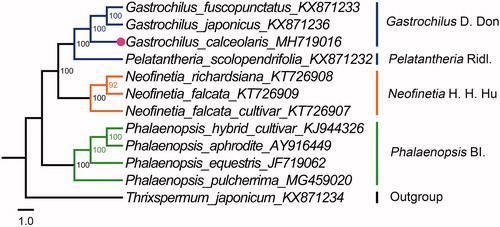Abstract
This study reported the complete chloroplast genome of a critically Endangered Orchidaceae species Gastrochilus calceolaris and its phylogenetic position in subtribe Aeridinae based on 12 orchid species plastomes. The plastome of G. calceolaris, with a 148,428 bp size, consisted of a pair of inverted repeat regions of 25,950 bp, a small single copy region of 11,139 bp, and a large single copy region of 85,389 bp. G + C content was 36.8%. The phylogenetic analysis highly supported the sisterhood between Gastrochilus and Pelatantheria and a monophyletic Gastrochilus group comprising of G. calceolaris, G. fuscopunctatus, and G. japonicus.
Gastrochilus calceolaris as the type species of genus of Gastrochilus (58 species included) is widely and variously distributed in the tropics and subtropics, mainly distributed in the southwest China, Bhutan, India, Malaysia, Indonesia, Nepal, Thailand and Vietnam at elevations of 1000–2700 m (Pathak et al. Citation2011). Currently, it has been listed as critically Endangered due to its geographical restricted distribution and the excessive collection (IUCN Citation2017). With rapid development of the second-generation sequencing technology, the chloroplast genome information was widely used for studying taxonomy, phylogeny, evolution, and ecology in plants (Jheng et al. Citation2012). However, few genomic data reported about G. calceolaris even the genus of Gastrochilus. Here, we displayed the first complete chloroplast genome of G. calceolaris deposited in GenBank (Accession Number: MH719016).
We used 5 g young leaves of G. calceolaris collected in the north of Myanmar to extract DNA accord to the modified CTAB method (Doyle and Dickson Citation1987). The voucher was deposited at the Biodiversity Research Group of Xishuangbanna Tropical Botanical Garden (Accession Number: XTBG-BRG-TFX0063). We used NGSQC Toolkitv2.3.3 software to filter the low-quality reads (Patel and Jain Citation2012). High-quality reads were de novo assembled into long reads (Contigs) by CLC Genomics Workbench 11.0 software (https://www.qiagenbioinformatics.com). The genome of G. calceolaris was assembled by using BioEdit software (http://www.mbio.ncsu.edu/bioedit/bioedit.html) accord to known reference chloroplast genomes G. fuscopunctatus and G. japonicus (Accession Number: KX871233 and KX871236). Then we used the Dual Organellar Genome Annotator (DOGMA) software to annotate the gene type of G. calceolaris (Wyman et al. Citation2004).
The chloroplast genome of G.calceolaris, with a 148,428 bp size, containing a pair of inverted repeats (IRs) of 25,950 bp, a small single copy (SSC) region of 11,139 bp and a large single copy (LSC) region of 85,389 bp. G+C content was 36.8%. In LSC, IR and SSC region, G+C content were 34.0, 43.1 and 28.2%, respectively. Additionally, we annotated 102 different genes, including 68 protein-coding genes, 30 tRNA genes and 4 rRNA genes. The NADH dehydrogenase (ndh) gene ndhA, ndhB, ndhC, ndhD, ndhE ndhF, ndhG, ndhH, ndhI, ndhJ and ndhK were pseudogenes. We detected 16 genes contained introns, amount which, 13 genes (trnK-UUU, rps16, trnG-GCC, atpF, rpoC1, trnL-UAA, trnV-UAC, petB, petD, rpl16, rpl2, trnI-GAU, and trnA-UGC) had a single intron, 3 genes (ycf3, clpP, and rps12) had two introns. rpl22 gene straddled LSC/IRa border, and ycf1 gene straddled IRa/SSC and SSC/IRb border.
To confirm the phylogenetic position of G. calceolaris in Aeridinae, We utilized 12 species chloroplast genomes of Aeridinae to construct the phylogenetic tree by using MEGA version 5.0 program (Tamura et al. Citation2011), Thrixspermum japonicum as outgroup. The plastomes were aligned by MAFFT version 7 software (Katoh and Standley Citation2013). A maximum likelihood method for phylogenetic analysis was performed base on GTR + I+G model in the RAxML version 8 program with 1000 bootstrap replicates (Darriba et al. Citation2012; Stamatakis Citation2014). In the phylogenetic tree (), G. Celceolaris clustered with G. fuscopunctatus and G. japonicus as a monophyly with a 100% bootstrap value. The phylogenetic analysis highly supported the sisterhood of Gastrochilus and Pelatantheria.
Data archiving statement
The plastome data of the G. calceolaris will be submitted to Genebank of NCBI through the revision process. The accession numbers from Genebank must be supplied before the final acceptance of the manuscript.
Disclosure statement
The authors report no conflict of interest.
Additional information
Funding
References
- Darriba D, Taboada GL, Doallo R, Posada D. 2012. jModelTest 2: more models, new heuristics and parallel computing. Nat Methods. 9:772
- Doyle JJ, Dickson EE. 1987. Preservation of plant samples for DNA restriction endonuclease analysis. Taxon. 36:715–722.
- IUCN. 2017. The IUCN Red List of Threatened Species. Version 2017–3 [accessed 2018 Apr 12]. www.iucnredlist.org.
- Jheng CF, Chen TC, Lin JY, Chen TC, Wu WL, Chang CC. 2012. The comparative chloroplast genomic analysis of photosynthetic orchids and developing DNA markers to distinguish Phalaenopsis orchids. Plant Sci. 190:62–73.
- Katoh K, Standley DM. 2013. MAFFT multiple sequence alignment software Version 7: improvements in performance and usability. Mol Biol Evol. 30:772–780.
- Patel RK, Jain M. 2012. NGS QC toolkit: a toolkit for quality control of next generation sequencing data. PLoS ONE. 7:e30619
- Pathak P, Piri H, Vij SP, Mahant KC, Chauhan S. 2011. In vitro propagation and mass scale multiplication of a critically endangered epiphytic orchid, Gastrochilus calceolaris (Buch.-Ham ex J.Sm.) D.Don. Indian J Exp Biol. 49:711–716.
- Stamatakis A. 2014. RAxML version 8: a tool for phylogenetic analysis and post-analysis of large phylogenies. Bioinformatics. 30:1312–1313.
- Tamura K, Peterson D, Peterson N, Stecher G, Nei M, Kumar S. 2011. MEGA5: molecular evolutionary genetics analysis using maximum likelihood, evolutionary distance, and maximum parsimony methods. Mol Biol Evol. 28:2731–2739.
- Wyman SK, Jansen RK, Boore JL. 2004. Automatic annotation of organellar genomes with DOGMA. Bioinformatics. 20:3252–3255.

